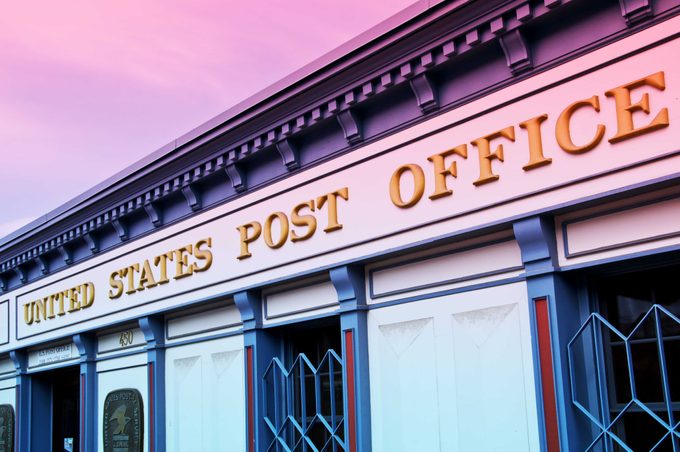The history of USPS is as old as the history of America

16 Surprising Facts About the U.S. Post Office


The first organized postal system in the United States was officially established on July 26, 1775, and it’s been an integral part of American society ever since. From delivery by horseback to the square trucks your mail carrier uses today, the postal system has gone through many changes since colonial days, and the United States Postal Service (USPS) as we know it was created in 1971. Yes, the history of USPS is a long one, but operating losses and threats to privatize this stately feature of American life keep its future uncertain.
Reader’s Digest put together these 16 interesting facts about the history of USPS and earlier postal services. Keep reading to brush up on these facts about the beloved mail delivery system that traces its roots back to the founding of our country.
Get Reader’s Digest’s Read Up newsletter for more history, humor, travel, tech and fun facts all week long.
1. The first post office was in a bar
The very first post office in colonial America was established in 1639 in the Boston home—which was also a tavern that sold “stronge water”—of a man named Richard Fairbanks.
2. American newspapers largely owe their existence to the post office
As part of the Post Office Act of 1792, newspapers—which were seen by the Founding Fathers as essential for maintaining an educated citizenry—were permitted to be mailed at extremely low rates. The result? By the start of the 19th century, newspapers made up the bulk of the U.S. mail. In 1840, 91% of white American adults could read, a literacy rate attributed in part to the widespread availability of newspapers.
3. The same Post Office Act imposed the death penalty on mail thieves
Because the U.S. mail was the only official way to send money, this severe punishment was less a reflection of the government’s cruelty and more an indication of the importance of safe postal delivery. Congress soon reconsidered, and in 1799, stealing mail for first-time offenders was punishable by a public whipping and a prison sentence of up to 10 years. However, second offenders were still subject to death, which was unchanged until 1872.
4. The postmaster general was once a semi-celebrity
The job was viewed as so critical to a young United States that John McLean, postmaster general from 1823 to 1829, reported directly to President James Monroe and then to President John Quincy Adams. In later years, McLean was viewed as a serious presidential candidate. His next position after Postmaster General? U.S. Supreme Court Justice.
5. For 141 years, getting a job at the U.S. postal system depended on one thing: connections

Beginning with Thomas Jefferson’s presidency (1801–1809), it became a tradition—albeit an unethical one—for the winning candidate to fire a significant swath of federal employees and replace them with party loyalists. When Andrew Jackson was elected to the Oval Office in 1828, he went further and tied this political perk to the postal service, which at the time accounted for roughly 75% of all civilian federal employees. He made it customary for the new president to fire many of the postal workers and hand out the positions to supporters. Astonishingly, this practice continued all the way until 1970, when it was abolished by Congress and President Richard Nixon.
6. The postmaster general used to be in the line of succession to the presidency
President Jackson also decided that the Postmaster General should sit in the Cabinet, thereby putting the office on the same level as the Secretaries of War, Treasury and State—and putting the PG in contention to be the Commander in Chief. True, the Postmaster General was last in line, but that still put him or her a heartbeat, or a dozen, away. The Postmaster General was finally removed from the Cabinet and from succession in 1971.
7. Until the mid-19th century, recipients had to pay the postage on letters they received
As a result, people tended to refuse letters to get out of paying for them, which caused the post office to spend an inordinate amount of time returning mail to senders. The solution? Postage stamps were introduced in America in 1847, and in 1856, the prepayment of mail became mandatory.
8. The U.S. mail was the original enabler of trolls
In the 19th and early 20th centuries, insulting “vinegar” or “poison” valentines were a popular trend in America and England. These cards featured a male or female caricature of popular stereotypes, like a miser or a spinster, accompanied by a mean-spirited verse. Here’s a sample: “Hey, Lover Boy, the place for you/Is home upon the shelf/‘Cause the only one who’d kiss you/Is a jackass like yourself!”
9. The Pony Express was never part of the U.S. postal service

Contrary to popular belief, the rugged Pony Express was a trailblazing private mail service that took on the difficult task of bringing correspondence through the West more quickly than the U.S. postal service. Officially called the Central Overland California & Pike’s Peak Express Company, it was in business for a year and a half, from April 3, 1860, to October 26, 1861. Scrappy riders—orphans preferred, according to help-wanted ads—ferried letters from St. Joseph, MO, to San Francisco, galloping through the Great Plains, the Rockies and the High Sierras.
10. Everyone had to go to the post office to get mail
It wasn’t until 1863 that you could get mail delivered to your house. Free city delivery was first launched in Cleveland, supposedly after postal clerk Joseph Briggs saw so many women forced to wait in long, cold lines at the post office, waiting to get news of loved ones fighting in the Civil War. His free city delivery service was such a success that it quickly spread to other cities before becoming the national norm. Money orders were another postal innovation prompted by the Civil War, when they were used by Union soldiers to send money home safely.
11. Postal clerks in the 19th century tended to be male—except at the Dead Letter Office
Starting in 1825, all mail that was unlabeled, mislabeled or insufficiently labeled in America was sent to a central Dead Letter Office (DLO) in Washington, DC. This was the only place where people who weren’t a letter’s intended recipients were allowed to open someone else’s mail. The postal employees hired for this job needed to be honest, so they wouldn’t pilfer the mail they had access to. And because women were seen back then as being more honest than men, DLO staff overwhelmingly consisted of women. (Clergy also worked there.) For years, the DLO was even a popular tourist destination. Today it is not, and it goes by the much less dramatic name “Mail Recovery Center,” with branches located in Atlanta, St. Paul, MN, and San Francisco.
12. Mail carriers should have been called mail waiters
Even as mail started getting delivered to people’s homes, mail carriers still had to hand it directly to the recipient. This meant postal workers had to wait, or circle back repeatedly, until the right person came home. On March 1, 1923, a regulation went into effect that required all U.S. homes to have a mailbox or slot, and just like that, postal employees no longer had to worry about patrons—just their dogs.
13. Your mailman used to be able to bring you greens, eggs and ham
From 1914 to 1920, the Farm-to-Table program was a novel initiative that allowed farmers to set prices and directly mail their wares to people in urban areas. Farm-fresh goods that were shipped included meats, poultry, eggs, butter, cheese, nuts, maple syrup, honey, preserves, fruits and vegetables. The initiative was seen as a way to give farmers more customers and city dwellers greater and cheaper access to fresh goods. And when World War I started, the program was touted as a way to help meet President Woodrow Wilson’s food conservation goals. The two most popular Farm-to-Table products (though not the craziest things ever shipped)? Butter and lard.
14. The Hope Diamond was shipped via U.S. mail

In 1958, New York City jeweler Harry Winston donated the 45.52 carat Hope Diamond—valued at $350 million today—to the Smithsonian. He so trusted the U.S. Post Office Department, predecessor of the USPS, which he regularly used to send jewels, that he used it to transport one of the world’s most valuable gems. The cost of registered first-class postage was $2.44 (around $26.91 today), and Winston paid an additional $142.05 (roughly $1575.29) to insure it for $1 million. It arrived safely at its destination, and the Smithsonian still possesses the original packaging with the postmarks. Unfortunately this little slice of USPS history isn’t on display, but the Hope Diamond is.
15. The U.S. Postal Service has no official motto
“Neither snow nor rain nor heat nor gloom of night stays these couriers from the swift completion of their appointed rounds.” Those are the words engraved on the front of New York City’s majestic 1912 James A. Farley Post Office, but they were taken from a fifth-century B.C. book by the Greek historian Herodotus. And they refer not to America’s stalwart men and women in (postal) blue but to messengers in the ancient Persian Empire. This quote was selected by an employee at McKim, Mead & White, the architectural firm that built the post office, and forever set in stone—at the post office and in people’s minds.
16. The postmaster general is the third-highest paid government employee
The U.S. president earns a base salary of $400,000 a year, and the postmaster general gets a base salary of $303,460. (The chief justice of the supreme court gets $317,500.) That means the current postmaster general, David Steiner, out-earns the U.S. vice president, who makes just $235,100.

Why trust us
At Reader’s Digest, we’re committed to producing high-quality content by writers with expertise and experience in their field in consultation with relevant, qualified experts. We rely on reputable primary sources, including government and professional organizations and academic institutions as well as our writers’ personal experiences where appropriate. We’ve gone the extra step and had Ambrose Martos, a fact-checker with 20-plus years of experience researching for national publications including National Geographic Adventure and Popular Mechanics, verify that all facts, studies and quotes are correct. Read more about our team, our contributors and our editorial policies.
Source:
- How the Post Office Created America: A History by Winifred Gallagher























